Sun-filtered Images Of Life, Memory, And Imagination
1984/FRENCH/DIRECTED BY BERTRAND TAVERNIER
STREET DATE: DECEMBER 17TH, 2019/KINO CLASSICS
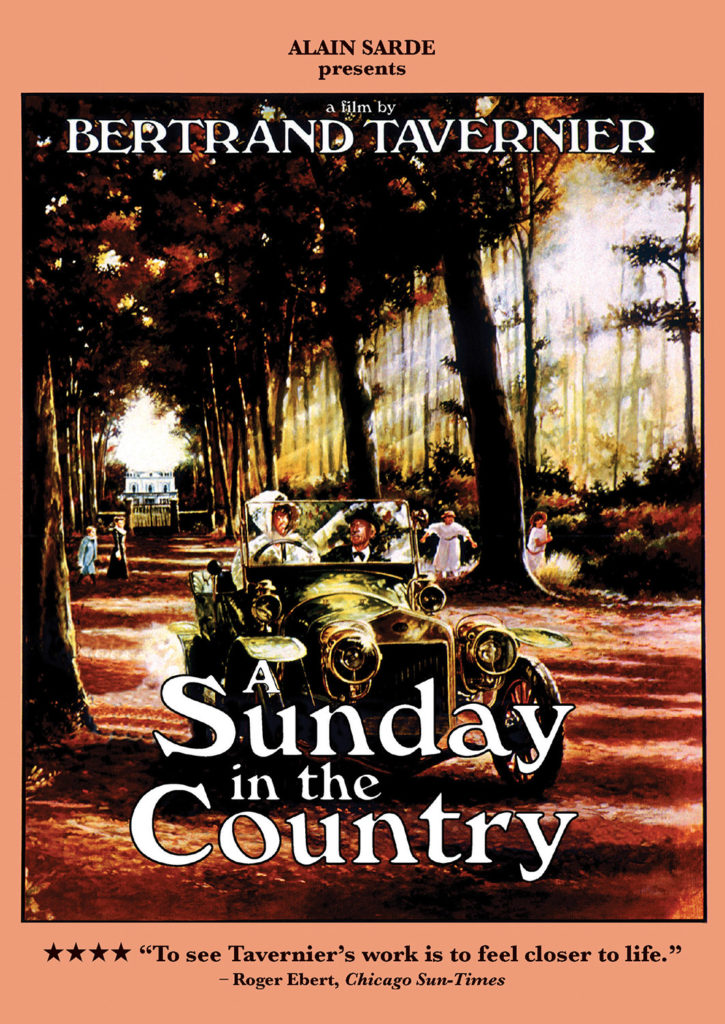
A French countryside Sunday 108 years ago provides both the narrow dramatic focus and a broader thematic tableaux of a family photographic album brought to vivid life. The English title A Sunday in the Country as poetic sounding as its French Un Dimanche à la campagne, Bertrand Tavernier’s study of a widowed septuagenarian painter and his visiting children and grandchildren — descriptive of but by no means restrictive to its historical time (pre-first World War) and geographical setting (the northern French countryside) — lingers in the viewing memory well past a late summer garden window-framed by the setting sun. Like a streaming flow of expression, movement, and thought, the emotional resonance of music, lighting, and framing impart each second of its 94 minutes with a keenly felt atmosphere of recognition. And like the literal flow of reflecting waters streaming by an outdoor café, on a pastoral sabbath afternoon over a century past, A Sunday in the Country is universal for its very specificity.
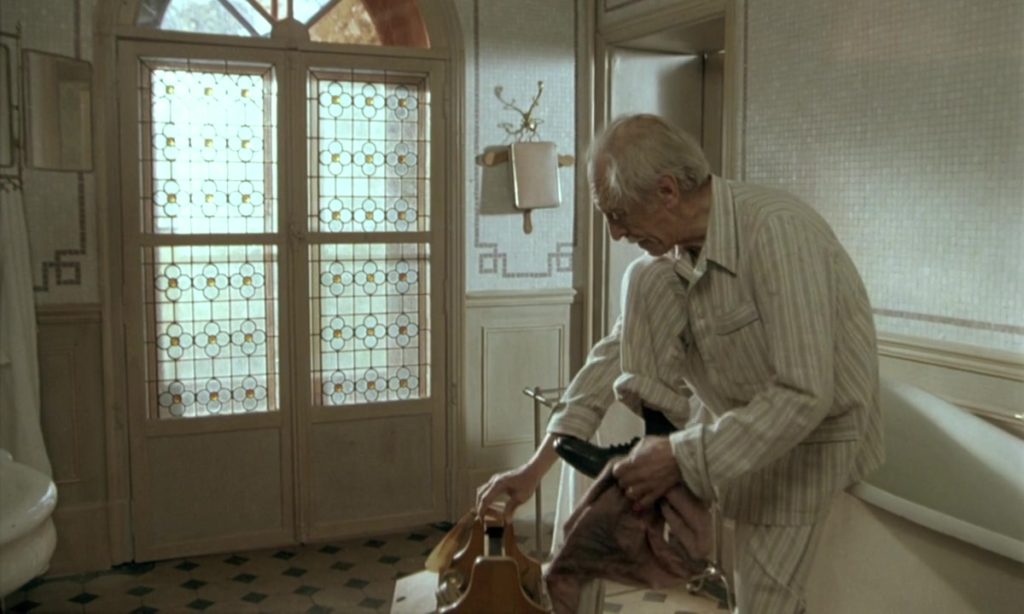
Monsieur Ladrimal (Louis Ducreux) prepares for his family’s arrival later that morning while bickering with his servant of several decades, Mercédès (Monique Chaumette). As the venerable Monsieur Ladrimal washes, dresses, breakfasts, and potters purposely through his well-appointed living rooms and adjoining studios, the many paintings on the walls, a furniture display model, and a half-finished canvas tell us we are in the home of an established portrait artist.
Monsieur Ladrimal strolls along a sunlit path to meet his dutiful son Gozangue (Michel Aumont), devout daughter-in-law Marie-Thérèse (Genevieve Mnich), and three young grandchildren (Thomas Duval, Quentin Ogier, Katia Wostrikoff) at the local train station. On the way back to the family estate, Gonzague shares a subdued conversation with his partially distracted father while Marie-Thérèse stops off at the town cathedral for the end of a Mass. The boys Emile and Lucien race around the slowly walking adults and the youngest girl Mireille trails pensively behind.
Later that afternoon, much to the unexpected delight of her father, the vivacious Irène (Sabine Azéma) blows in from Paris by motorcar. The formerly sedate day subtly changes to a comparative whirlwind of activity around open-air motor-rides, vintage cloth-hunting, lawn games, and a waning afternoon visit to an outdoor café. Across the table from his daughter, and even momentarily on the dance-lawn, Monsieur Ladrimal shares possibly the happiest moment of his elder years to the carnivalesque strains of an accordionist’s (Marc Perrone) pavilion band and the picturesque drama of life unfolding along the banks of the Seine River; courtesy of the café patron (Jacques Poitrenaud), a young serving girl (Pascal Vignal), and an over-amorous fisherman (Jean-Roger Milo).
The elusive promise of a family dinner is broken, however, when a mysterious phone call sends a distraught Iréne motoring furiously back to Paris, and Monsieur Ladrimal returns home later that still sunlit evening after seeing his son, daughter-in-law, and grandchildren off on their train journey back to upper middle-class life in the suburbs. Pausing by the gate to his estate, abstractly massaging his chest, Monsieur Ladrimal turns to see, as he has throughout the course of the day — either in his mind, memory, or some combination of both — a pair of girls in white dresses (Valentine Suard, Erika Faivre) playing in the sun-dappled forest clearing.
Strolling past his house to his adjoining studio, Monsieur Ladrimal concludes his day by slowly replacing his half-finished canvas and then turning the easel towards his former painting-view. Seated on the sofa, Monsieur Ladrimal smilingly contemplates the now empty canvas as the day reaches its end.
Outside, past the studio’s bay-window, the setting sun continues to shine on the garden with an intensity precisely equal to early morning.
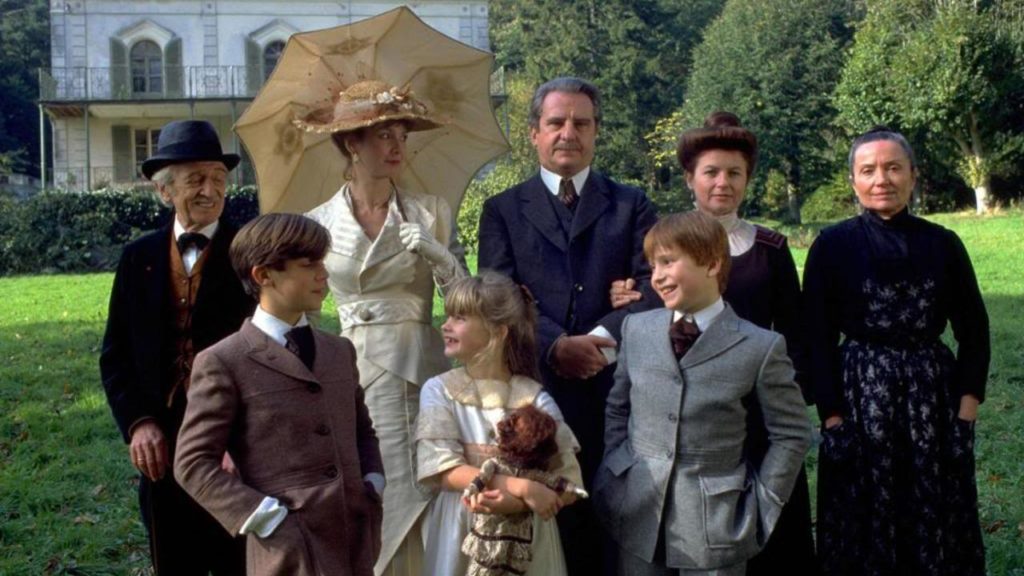
And that singular intensity, one hopes, will shine through a brief account of the unique genesis and startling technique of A Sunday in the Country.
The publication of Pierre Bost’s 1945 novella Monsieur Ladrimal va bientôt mourir coincided with the start of Bost and writing partner Jean Aurenche’s extensive and influential screenwriting career — including such enduring classics of French postwar cinema as René Clément’s Forbidden Games (1952) and Claude-Autant Lara’s Le Rouge et la Noir (1954) — that soon attracted the enduring enmity of the emerging French New Wave when identified as “old-fashioned” by then-journalist and film critic François Truffaut in his infamous 1954 polemic, “Une Certain Tendance du Cinéma Français” (A Certain Trend of French Cinema). The critically ironic “Cinema of Quality” label would follow Bost and Aurenche for the remainder of their careers; which, as an additionally wonderful irony, would artistically end with the venerable screenwriting duo’s brilliant script for Bertrand Tavernier’s third film as director, 1976’s acclaimed The Judge and the Assassin, past Pierre Bost’s death in 1975.
Tavernier himself a onetime journalist and critic-turned-filmmaker, the historical and artistic appropriateness of the deceptively sedate “Cinema of Quality” merging with the unfettered expressivity of the French New Wave — which in part sought to ‘reclaim’ the more uniquely ‘personal’ French prewar cinema of René Clair, Jean Vigo, and Jean Renoir — revises and repurposes a backwards-looking but forward-thinking combination of equally valid cinema trends. In Tavernier and co-screenwriter Colo’s family patriarch Monsieur Ladrimal, as played by elderly composer and theater director Louis Ducreux, the decorated “Artist of Quality” paints financially lucrative scenes of pastoral realism contemporary to but contradistinctual with the more “revolutionary” modes of artistry found (and name-referenced throughout A Sunday in the Country) in Degas, Matisse, and Pierre-Auguste Renoir.
So, if a Ladrimal fails to resonate in artistic retrospect when aesthetically and historically compared to an elder Renoir, the Taverniers and actor Ducreux have nevertheless imbued the emotional life, memories, and imagination of the painter-bourgeois with an artistic charity worthy of Renoir’s son Jean. (At which point it may be worth noting the similar title and setting to Renoir fils’ unfinished 1936 film A Day in the Country alongside Tavernier’s source material re-titled A Sunday in the Country.)
In short, A Sunday in the Country rescues the past to illuminate the present. In its technique, beautifully capturing this artistic aim, Bruno de Keyzer’s sun-filtered imagery shimmers imperceptibly through graceful interiors and glowing exteriors alike, while non-diegetic piano selections from story-contemporary composer Gustave Fauré rustle through the soundtrack like late summer wind in the leaves. And then there’s The Voice. As spoken by director Tavernier, and as taken directly from Bost’s story and embellished by Tavernier’s co-writer (and ex-wife) Colo, A Sunday in the Country’s third-person narration — little-used or possibly ineffective in this viewer’s memory of English-language films outside of 1940’s film noir docudramas, 1950’s TV police thrillers, and 2001’s The Royal Tennenbaums — amplifies and expands the inner lives of its characters with both witty detachment and devastating aplomb; marking the deliberate morning rituals of an elderly man, the pitiless state of an unloved son, or a loving aunt silently reading an early death in her innocent young niece’s palm with a matter-of-fact poetry ideally born of unvarnished prose.
Perhaps most striking, however, is A Sunday in the Country’s use of space with time: the film equally and imperceptibly gliding through Ladrimal’s memories of his late wife (Claude Winter), son Gonzague’s entirely plausible imagining of his father eventual (and possibly soon-to-be) death, and another country Sunday of twenty years before spent on a lawn and garden little changed by the intervening seasons. Imagery, music, narration, and finally reflection — both visual and contemplative — serve harmoniously to evoke one fleeting day in the life of a family. By the end, not only may we come to know more about the Ladrimals than we may ever know of our own family –- including its past, present, and future — but we may also feel we have spent A Sunday in the Country along with them.
…
Kino Classics’ Blu-ray — with its poster-cover image perfectly denoting many of the visual and thematic elements described above — includes a recent English-spoken commentary from A Sunday in the Country’s 78-year-old director, Bertrand Tavernier. The filmmaker, now Monsieur Ladrimal’s companion in age in addition to personality, is warm and inviting in his film-length description of the film’s inspiration, production, and especially its technique.
Of particular interest is Tavernier’s account of his collaboration with cinematographer Bruno de Keyzer. After many set and location tests, which were challenged by the natural lighting favored by Tavernier’s dramatic and de Keyzer’s visual style, the filmmakers found a high-contrast motion-image sustainable through lengthy, unbroken camera takes, allowing the story to unfold and the characters to reveal themselves with a historical immediacy approaching period photographs.
Directly inspired by (again, story-contemporary) French camera, film, and photography pioneers Louis and Auguste Lumière, Tavernier and de Keyzer essentially recreate the Lumière’s little-known but fondly remembered early photographic color process called Autochrome, whose delicate shading and subtle effect:
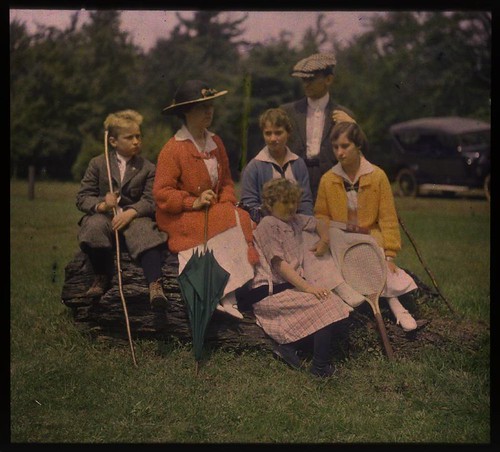
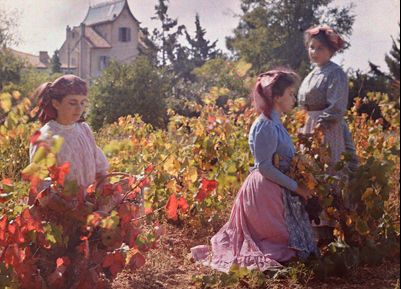
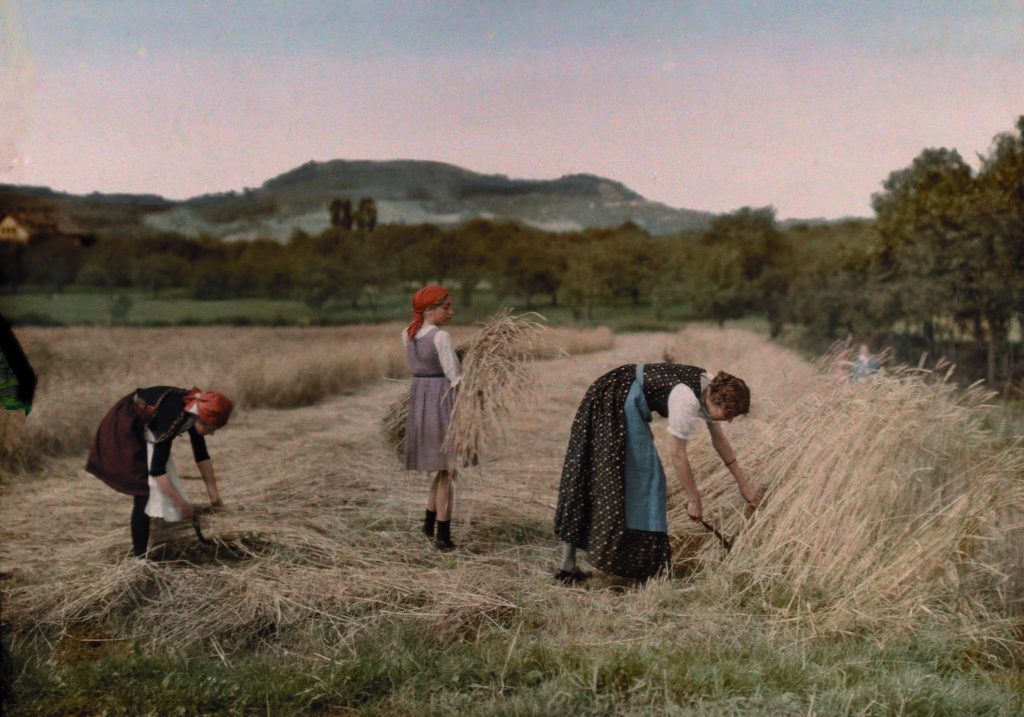
continues to charm anyone who has seen it. With a visual quality purposely reminiscent of Autochrome’s subtlety and detail — whose previously employed adjectives of “shimmering”, “glowing”, and “shining” fail to adequately describe — A Sunday in the Country once again in viewing imperceptibly links the motion-image with our own experiences, memories, and emotions. Breaking insuperable distances of space and time, this Sunday in the Country — across an ocean and 108 year of elapsed time at the time and place of writing this review — becomes our own.
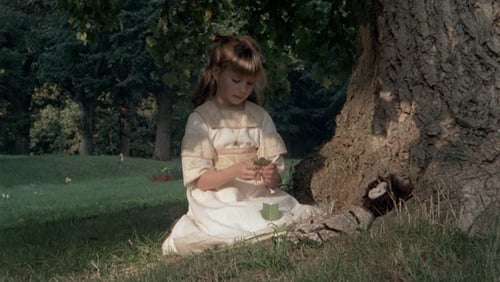
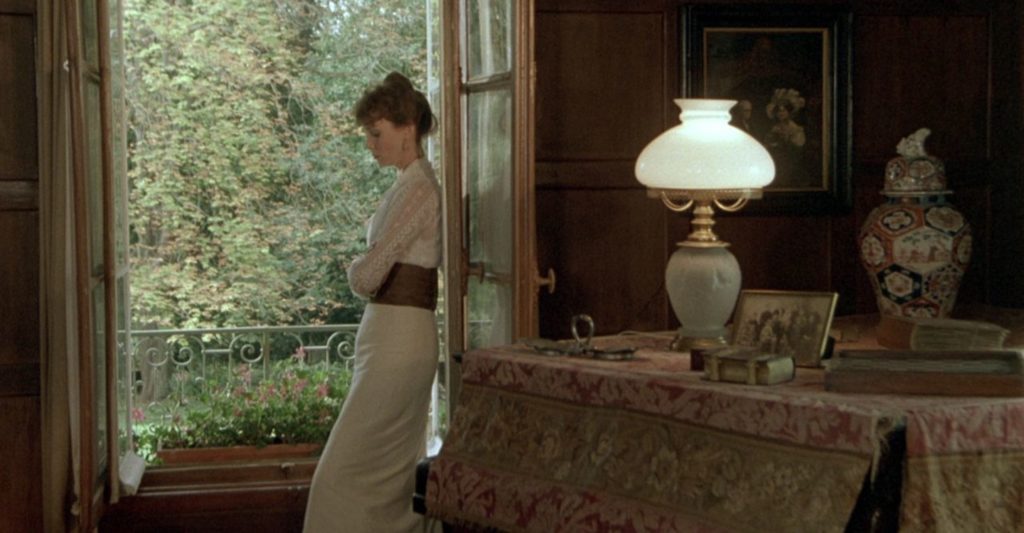
Which as a final note is why KC’s Blu-ray presentation of A Sunday in the Country is so important. Fading to near screen-blackness whenever the camera moved under a shadow canopy or through an underlit corridor on this viewer’s previous visit to the French countryside of 1912 — when first seen on a warped VHS transfer twenty-five years ago — A Sunday in the Country effectively retains every visual and audio portion of its original presentation on Blu-ray. In a manner commensurate to Tavernier’s artistic aim, Kino Classics brings A Sunday in the Country to vivid reality: not only the life of a family, the life of a painter, or the life of the past, but quoting critic Roger Ebert’s blurb on the back, “closer to life” itself.
The images used in this review are taken from a variety of fair-use sources for visual reference only and are not meant to reflect the visual quality of Kino Classics’ Blu-ray. Thanks to Kino Lorber for providing a Blu-ray copy.

